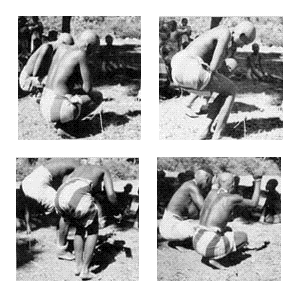NDAYO DZA VHUSHA:
EDUCATIONAL SONGS AND DANCES OF VHUSHA
All of the songs discussed up until now are all called nyimbo dza vhusha (songs of vhusha), and they are an essential part of the rites of the school. It is for this reason that the Venda say that a girl goes to vhusha to 'be sung for' (-imbelwa). The 'signal' song, which warns people that a novice is being taken out, is called muulu; and the song of the school which is sung at the ruler's place is called 'the great song of vhusha' (luimbo luhulwane lwa vhusha).
All the other songs are called ndayo dza vhusha (lit. orders, commands, exercises of vhusha). Some of them may be heard at all schools in Vendaland, but others seem to be limited in distribution to certain areas. These may be original compositions by graduates of the school, or adaptations of beer-songs, children's play-songs and so on, for ndayo dancing.
| The basic position and movements of most ndayo dances (- |
| (i) | The dancers squat (-tumba), with arms folded against the chest in the vhusha humble position. |
| (ii) | They rise to a crouching position. |
| (iii) | They shuffle their feet rapidly or 'jab' the metatarsal arch into the ground in time to the different multiple rhythms of each song. |
| (iv) | Very often, as the dancers rise rapidly from the squat to the crouch position, they swing their arms downward. This movement makes it easier to raise the body rapidly. |
| (v) | Similarly, when they resume the squatting position, they throw up their arms, bending them at the elbow. |

Ndayo are usually danced by two girls at a time. Since the variation in movements depends primarily on variations in the metre of the songs, I will describe here only those movements which depart radically from the system outlined above.
The function of ndayo, apart from being strenuous exercise and an essential feature of vhusha, is best described in the words of one mistress of initiation: "Ndayo are there to make the girls suffer and honour the old ones. They reinforce the pattern of seniority. That is the lesson they teach." As will be seen, some are designed to reinforce specific instructions about behaviour, although the movements often seem to have little to do with the lessons. One woman even suggested that the movements were intended to aid child-birth, presumably in the same way as pre-natal exercises. But when one considers the variety of interpretations that are often given to the same ndayo, and some graduates' complete ignorance of any interpretations at all, the sociological explanation of the mistress of initiation seems the most appropriate.
In presenting the songs here, I give first those which are considered to teach the girls a lesson (Songs Nos. 15-40, and then those which appear to have no lesson. Amongst the former are found almost all the best-known songs. Most of them are little more than jingles expressing only a single thought or phrase, but it must be remembered that their most important features are their metre and the dance movements. In fact, when several ndayo are performed in succession, it seems that the choice of each song is influenced by rhythm, and sometimes by the melody, of its predecessor, rather than by the words. Furthermore, song-leaders rarely sing more than one or two different 'lines', and in both solo and chorus parts words are often replaced by syllables such as ahee, uwee, yowee etc.